In early January of 1832, Zerah Pulsipher stood in the barn-like Baptist building in Spafford, addressing the members who had gathered at his request to hear about his recent experiences. He told them of angels appearing to him to tell him that Mormonism’s Gold Bible was “the great revelation of the last days” and that he intended to join the newly-organized Church of Christ. Not long afterwards, he stood in the frigid waters of a New England river with Jared Carter—a Mormon missionary—who stated, “Having authority given me of Jesus Christ, I baptize you in the name of the Father, and of the Son, and of the Holy Ghost. Amen”,[i] following which Zerah was immersed in the icy stream and came up baptized as a Mormon. Many others from his family and congregation had or soon would join him in doing so. What led this devote Christian to be rebaptized? How did this affect his life immediately afterwards? What changes came to the community because of Jared Carter’s visit?
A Baptist Church similar to the one in Spafford stood in Rockingham, Vermont—Zerah’s birthplace. That community building was constructed on lands at least partly donated by Zerah’s grandfather David Pulsipher.[ii] David was one of the original nineteen members of that church and was a large man of great energy, deeply interested in public affairs, in the education of his children, and in the church. These interests were passed on to David’s son, John, who was another founding member of the Baptist church in Rockingham and was also a leading man in public affairs. [iii]
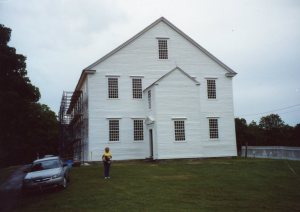
Image courtesy of familysearch.org.
Born into a religious family, Zerah was—at times—contemplative and given to serious reflection. When he was fourteen or fifteen years old, he had an experience that seems to have played an important part of his spiritual journey. According to his account: “One evening as I was sitting by the fire-side in my father’s kitchen alone, a sudden influence over-powered my mind to such an extent that I lost sight of everything on earth for some time, I never knew how long.” He seems to have considered this some sort of near-death experience, since his next comment in his autobiography was that, “it was necessary that more preparation should be made before I should be willing to pass the Vale of Death.” This event seems to have been that it caused him to think about religion and life after death more than before, because his next statements dwell on his religious thoughts.[iv]
It was an actual death in the family that caused more serious reflections on his faith. His first marriage ended not long after it began, as his wife died in December of 1812, just two years after he married her. Although he wasn’t able to reconcile himself to the idea that souls would be left in Hellfire to all Eternity, he still “had some anxiety about her state and condition” in the afterlife. A few weeks after her death he had a special manifestation to comfort him in his grief:
She came to me in vision and appearing natural looked pleasant as she ever did and sat by my side and assisted me in singing a hymn—beginning thus: “That glorious day is drawing nigh when Zions Light Shall Shine.” This she did with seeming composure. This vision took away all the anxiety of my mind concerning her in as much as she seemed to enjoy herself well…. My mind became calm as respecting her condition in the spirit world.[v]
Not only did this vision calm his concerns about his wife, but he also noted that, “this hymn which she introduced and sang with me applied to the great work of the Last Dispensation of the Fullness of Times”—a reference to the future Mormon movement.
Cultural Preparation
In addition to his religious upbringing, Zerah was well-prepared by the culture he lived in to join the Mormon movement when missionaries did come to his community. Like many of the early Mormon converts, Zerah grew up during the time of the Second Great Awakening—a fervent effort to restore righteousness and religious zeal in America, characterized by circuit-riding preachers, fiery-tongued evangelists, new grass-roots religious movements, and fervent emotionalism. As this movement worked its course in the six decades leading up to the Civil War, sporadic spiritual revivals erupted throughout the United States, causing an increase in active Christian church membership. The “ecclesiastical storm center” of this movement was western New York—an area that was in an almost constant state of revivalism. Revivals were so habitual in this region that historians have labeled it the “Burned-over District.” The grand climax of this religious zeal occurred between 1825 and 1837—the time period that the Pulsiphers lived in the area.[vi]
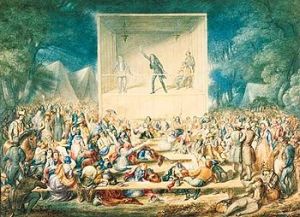
The Pulsiphers were a product of this time in several of their beliefs. Among those was the conviction that the time was that Christ’s Second Coming was coming soon. For example, Zerah’s father said that the signs of Christ’s second coming were often seen and that He would come before many years should pass away. “And if he did not live to see it, likely his children would.”[vii] The American and French revolutions had spurred speculation about the forthcoming coming of Christ and Millenarians saw the two revolutions as signs of the coming Millennium. Others, such as William Miller, created chronologies of millennial events by matching historic occurrences with scriptural predictions.[viii] Strange signs in the sky were also taken as indicators that the Millennium was close. When Zerah saw “the most extraordinary Northern Lights that I had ever saw” in the fall of 1814, he noted that “it was the cause of many speculative notions among the people” and that his father said that it was the signs of the last days and Christ’s coming. Zerah regarded his father’s remarks as “specimens of good sense.”[ix]
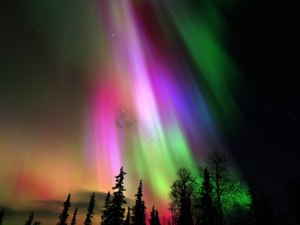
Another impulse that was common among the religious movements of the time was a desire for the restoration of the practices and teachings of the New Testament church. For example, Roger Williams—the founder of Providence, Rhode Island—stated that there was “no regularly-constituted Church on earth, nor any person authorized to administer any Church ordinance; nor could there be, until new apostles were sent by the great Head of the Church, for whose coming he was seeking.”[x] Solomon Chamberlain—a Methodist who became an early convert to the Church of Christ—reported that an angel told him in vision that there were “no people on the earth that were right; but that the Lord would in his own due time raise up a church, different from all others, and he would give power and authority as in the days of Christ.”[xi] Those who looked forward to a restoration of that church were known as “seekers,” “restorationists,” or “primitivists.”[xii]
Although Zerah was involved in the local Baptist church and felt that “there were some things among the Sects that appeared reasonable,” he was indeed a seeker. For years, he had contemplated the principles of religion and commented many times that “if the pure church with its gifts and graces was…on the earth… I had not found it. But I should be happy enough to find it in my day.” He felt that existing churches lacked “the principles of the ancient gospel with all its gifts belonging to it” and—as mentioned above—doubted that God would condemn souls to Hell for all eternity. Further, the vision of his first wife fueled his belief that a glorious day was drawing nigh when a new religious movement that had those gifts and principles would soon be founded.
Zerah’s wife Mary also had her doubts about the religion she had embraced. When she joined the Methodist church she was initially not baptized—the preacher just never suggested it. After being a member for a year, she approached the preacher and asked if believed baptism was a duty to obey. When he responded it was not a saving ordinance, she countered that, “I see by reading the New Testament, I consider it a duty—a command” and that it must be done by immersion. The preacher did not agree that it was to be done by immersion, but agreed to baptize her to settle her conscious, and had her baptized by kneeling in water and then pouring a little water on her head from the bank. Mary was unsatisfied and felt it was mockery, but pushed her minister no further at that time.[xiii]
For the time being, however, the Pulsiphers remained actively involved in the local Protestant churches, much like Zerah’s father and grandfather before him. While living in Spafford, Zerah was one of four members of the board of trustees at the Free Will Baptist church at the time a new church building was constructed in 1828. This sturdy building—the only church building in town—was jokingly called “God’s Barn” when it was first constructed, and with its large and respectable membership it gave promise of a long and useful career. After a Mormon proselyting wave struck the region, however, the church’s nickname proved painfully prophetic.[xiv]
The Gold Bible
The answer to Mary and Zerah’s religious concerns (and the death knell to the Free Will Baptist church in Spafford) came in the form of a very strange book: “in the summer of 1830 I heard a Minister say in Public that a golden Bible on some ancient Peoples were found in Manches<ter> N.Y. the sentence thriled through my sistem like a shock of Electricity.” Zerah later recalled that: “At the same time [I] thought it might be something that would give light to my mind upon principles that I had been thinking of for years.” [xv] One of the Pulsipher’s neighbors—a man by the name of Silas Hillman—also recalled that:
In the year 1831, a man by the name of Chamberlain came there bringing the Book of Mormon. He gave history of its origin, how it was obtained, and its translation. A young man by the name of Joseph Smith was visited by an Angel of the Lord, who informed him that a record of an ancient people that once inherited this land was hid up unto the Lord in a certain hill in Palmyra, New York. He was informed that if he would obey the instructions of the Angel, that in the due time of the Lord, he should have power to obtain record and have power given him to translate them which was fulfilled. And the men spoken of had the said translation printed and bound and it was called the Book of Mormon.[xvi]
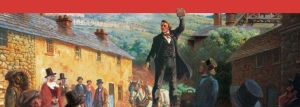
Image from Preach My Gospel.
The timing of the minister’s arrival is somewhat uncertain (hence the discrepancy of dates in the quotes above), though late 1830 seems most likely from the various accounts, but this book—which would have an immense impact on Zerah’s conversion to Mormonism—was a central part of the message of early Mormon missionaries. The Book of Mormon functioned most importantly as a sign that God had restoring the gifts and powers that the New Testament spoke of early Christian believers having—most notably through the seership of the young man mentioned by Chamberlain—Joseph Smith, Jr.
According to Joseph Smith’s own account, as a young boy he had “become seriously imprest with regard to the all importent concerns for the welfare of [his] immortal Soul” and through searching the scriptures and becoming acquainted with the “diferant denominations” in the town he lived in, came to the conclusion that “mankind did not come unto the lord but that they had apostatised from the true and liveing faith and there was no society or denomination that built upon the gospel of Jesus Christ as recorded in the new testament.” He was also “convicted of [his] sins.” Smith reported that during his distress over his religious questions that, “I cried unto the Lord for mercy for there was none else to whom I could go and obtain mercy and the Lord heard my cry in the wilderness.” He spoke of a vision where the Lord appeared to him, forgave his sins, and confirmed that, “none doeth good no not one they have turned asside from the gospel and keep not commandments.”[xvii]
Following this formative experience, Joseph reported several years of silence from God. Then, he recalled, “When I was seventeen years of age I called again upon the Lord and he shewed unto me a heavenly vision for behold an angel of the Lord came and stood before me and it was night.” In this vision, the angel reveled that, “In the Town of Manchester Ontario County N.Y. there was plates of gold upon which there was engravings which was engraven by Maroni [Moroni—the name of the angel] & his fathers the servants of the living God in ancient days and deposited by th[e] commandments of God… and that I should go and get them.”[xviii]
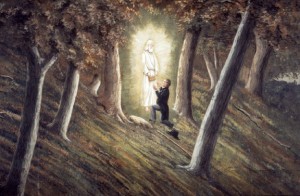
After four years of preparation, Joseph Smith was able to take the plates and with material support from friends and the help of a few scribes dictated a manuscript that would be published as The Book of Mormon in 1830. The book was written in biblical style as a record of a family of Israelites that the Lord led away from Jerusalem to the Americas about 600 years before Christ. The primary history spanned 1000 years, covering the ministries of many prophets who believed in and taught their people about Christ, Bible-like narratives of both righteous and wicked individuals, a personal visit from the resurrected Jesus Christ, and the wars and difficulties that the colony faced as it grew and split into two opposing factions. Ultimately, in the record, the righteous believers were exterminated by war and apostasy, but not before a prophet-historian named Mormon and his son Moroni abridged the history of his people and recorded it on golden plates that were preserved for the future. The book dwelt much on theological themes such as redemption through Christ, the scattering and gathering of Israel, and that the power and gifts of God are always available.
In addition to translating the Book of Mormon, Smith reported that he and his primary scribe—Oliver Cowdery—had received special authority to baptize, to confer the Holy Ghost, and to ordain priests and teachers from a series of angelic visitors. Further, they recorded a revelation in March 1829 wherein the Lord promised His people to “work a reformation among them, and… establish my church, like unto the church which was taught by my disciples in the days of old.”[xix] Shortly afterwards, Smith recorded another revelation wherein the Lord reiterated this promise, stating, “If this this generation harden not their hearts, I will establish my church among them” (D&C 10:53). Thus, Joseph Smith and the Book of Mormon became wedded to the formation of a new religion.
During the process of dictating the Book of Mormon, Smith began to gather a following, particularly among the families of those who were assisting in the translation process and a few other individuals believed that he was a prophet doing the work of God. These converts began to spread the news of Joseph Smith’s work, not even waiting for the Book of Mormon to be fully printed and published. Christian Whitmer, “Copied from the manuscripts the teachings and the doctrines of Christ, being the things which we were commanded to preach.” Thomas Marsh journeyed from Lyons, New York, to inquire about the “Golden Book” and left with the first sixteen pages of the Book of Mormon, fresh off the press.[xx]
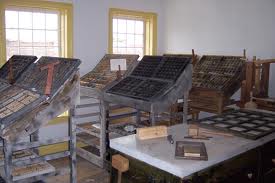
One of the more enthusiastic and eccentric investigators at this time was a man by the name of Solomon Chamberlin—presumably the same Chamberlain who first taught the people of Spafford about the Book of Mormon. Chamberlin was a visionary man who had joined the Methodists when he was 19 years old after having a “vision of the night” in which he saw the damned in hell “blowing up the flames and preparing red hot iron to lay their faces on to all eternity”, but later decided that “they (the Methodists) were wrong in many things.” After an 1816 vision of a meeting house, he attended a Reformed Methodist quarterly meeting and “saw the same house of worship.” Here, he experienced further visions of both Satan and Jesus, achieved sanctification and “went home rejoicing.” After living with these Reformed Methodists for a short while in a common stock system, he states that, “We found we were mistaken in many things” and he, “Felt very anxious to know whether there were any people on the earth whose principles were right in all things; for I was tired of all orders unless they had the true principles of God.”[xxi] He experienced a visitation from a deceased member of the Methodist society and was shown a vision wherein, he records,
The state of the society was now opened to my view, and I had a spirit of discernment, and could discern the sandy foundation that many of them were building on. I now fell on my knees and gave thanks to God for his condescention to unworthy me, and while lifting up my soul to God it appeared to me that I saw my Saviour stand before me with the bible in his hand, and said to me this is the book–live in the spirit that this was wrote and you shall shine in the enternal world on high.[xxi]
For the time being, Chamberlain wandered through various religions and regions, ending up in Wayne County in the fall of 1829, where he described himself as “living about 20 miles east of where the gold record was found, on the Erie Canal.” He heard about the Smiths and the “gold bible” while on a journey through Palmyra and visited Joseph Smith, Sr.’s household to learn more. After visiting for two days with Hyrum Smith—Joseph Smith, Jr.’s older brother—he learned about the “gold record” and obtained sixty four pages of the Book of Mormon at the printing office. Excited, Chamberlain rushed off to Canada to preach about this book. After travelling six or seven hundred miles and telling people about the “gold bible so called” and telling them to “prepare for the great work of God” he returned home.[xxi]
Around the time that Solomon Chamberlain returned home, the publication of the Book of Mormon was complete and on 6 April 1830, Joseph Smith, Jr. gathered 40 or 50 of his followers, six of whom acted as the charter members of a new church they formally incorporated and called the Church of Christ (the name was later changed to the Church of Jesus Christ of Latter-day Saints in 1838). Sometime afterwards, Chamberlain “took eight or ten” copies of the Book of Mormon, and “started off to sell and to preach; for you could not sell one without a great deal of preaching.” It was towards the end of this journey that Chamberlain’s path crossed with the Pulsiphers: “I returned home and on the way preached it to the Free Will Baptist Church, and they received it.”[xxii]
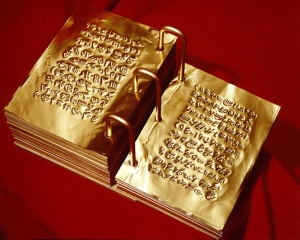
Since Zerah “thought it might be something that would give light to [his] mind upon principles that [he] had been thinking of for years” he had a deep interest in getting his hands on the Book of Mormon to find out more. As he would later recall: “In the fall of 1831 there was a Book of Mormon brought into town[.] I succeeded in getting it[.] I directly read it through twice[,] gave it a thorough investigation and believed it was true.”[xxiii] His son, John, would later recall that Zerah would get together “with the neighbors Elijah Cheney, [Shadrach] Roundy and others would sit and read and talk day and night ’till they read it through and through. They believed it was brought forth by the power of God, to prepare the way for the second coming of the Son of Man—it was just what they were looking for.”[xxiv] Zerah’s wife added that they, “Believed it, but did not know anything more about it. We were very anxious to know more about it.”[xxv] They were able to find out more from a missionary by the name of Jared Carter.
The Proselyting Wave Strikes
About the time that Zerah first had the chance to read the Book of Mormon, Jared Carter was preparing to leave form Kirtland, Ohio—the headquarters of the Church of Christ at the time. In Jared Carter’s journal, we read that: “After I had been to Kirkland[,] when I received the authority of an apostle [elder] commenced a mission to the east on 22nd day of Sept 1831 with Brother Eben Page.”[xxvi] Prior to this time, Jared had come in contact with the Book of Mormon, and “became immediately convi[n]ced that it was a revelation of God.” He,
concluded that I should go to See them [the Mormons] as soon as expedient…. Accordingly I went from Shenango a town in Broom County state of N.Y., where we lived to the town of Coalsville… & having an interview with them I felt it my duty to separate from Babylon and baptized[.] accordingly I was baptized by hyrum Smith about the 20th of February [1831].”[xxvii]
Jared was ordained a priest in June of that year and elder (as mentioned above) in September, prior to leaving on his mission. During this mission, he traveled with his companion through Ohio and New York, and then separated to take care of requests for missionaries to visit a few areas. He ended up working in Benson, Vermont, where he had previously lived. Then, Carter writes, “After it appeared that my work was done in this plase [Benson, Vermont] for the preasant I went on to the west to Spafford[,] a town in york state[,] onondaga County[,] where I commenced laboring in the ministry & the Lord began immediately to bless my labors.”[xxviii]
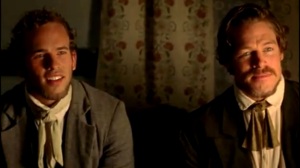
When Carter arrived in Spafford, New York in January 1832, there were several individuals in the community who were eager to hear what he had to say. They had “a great many questions to ask” about the Book of Mormon and his beliefs. As soon as Carter arrived, Zerah and two Methodist ministers came to him and, after proper introductions were given, began to question Jared about his beliefs. Zerah watched to see if he could find fault with the young missionary and asked about “the principles of the ancient gospel with all its gifts belonging to it.” When Jared answered that he believed in them, Zerah pressed further and asked whether he had ever laid hands on the sick and they had recovered. To this, the missionary responded that he had done so in many instances.[xxix]
Impressed, the Pulsiphers attended a service the following evening where Jared Carter preached to a crowded congregation. Mary recalled that Jared told them that baptism by immersion was the only right way and that it was for the remission of sins, which sounded right to her. He also told them how the Book of Mormon was found and translated by Joseph Smith. The missionary held up a copy of the Book of Mormon and declared it to be a revelation from God. Even though Zerah had been watching to find fault with this Mormon elder, he stated that “I could not gain-say anything he had said.”
When Carter sat down and gave liberty for remarks, Zerah perceived that those present seemed to be in a daze. He arose and stated that:
We had been hearing strange things and if true[,] they were of the utmost importance to us. If not true[,] it was one of the greatest impositions and as the preacher had said that he had got his knowledge from heaven and was nothing but a man and I the same, that I had just as good a right to obtain that blessing as he, therefore I was determined to have that knowledge for myself.
Zerah considered it his privilege from that time to make it a matter of fervent prayer. He did so for about a week and received a witness that the Book of Mormon and “Mormonism” were of God. According to his account:
As I was thrashing in my barn with the doors shut, all at once there seemed to be a ray of light from heaven which caused me to stop work for a short time, but soon began it again. Then in a few minutes another light came over my head which caused me to look up. I thought I saw the Angels with the Book of Mormon in their hands in the attitude of showing it to me and saying “this is the great revelation of the last days in which all things spoken of by the prophets must be fulfilled.” The vision was so open and plain that I began to rejoice exceedingly so that I walked the length of my barn crying “Glory Hal-la-lu-ya to the God and the Lamb forever.”
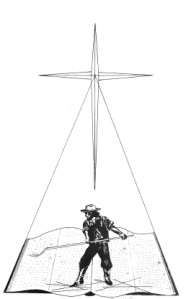
Image from The Pulsipher Family Book.
This vision had a powerful impact on Zerah’s life, as well as other members of the Free Will Baptist Church he attended. He recalled:
For some time it seemed a little difficult to keep my mind in a proper state of reasonable order, I was so filled with the joys of heaven. But when my mind became calm I called the church together, and informed them of what I had seen. I told them of my determination to join the Church of Latter Day Saints, which I did and a large body of my church went with me.[xxx]
On 11 January of 1832, Zerah and his wife, Mary, were baptized along with all their children who were old enough to do so (Almira, Sarah, and Mariah). Jared Carter recorded that “there was some displays of the healing power of god in this plase while I was here,”[xxxi] one of which occurred during the Pulsiphers’ baptisms. Mary recalled that:
I wanted to be [baptized] at the first opportunity, but Satan thought he would hinder it. The night before baptism, I was taken very lame with rheumatism or something. I was so sick I could not get around much. As they were fixing to go, Brother Carter said to me, “Sister Pulsipher, if you will do your duty, you shall be healed.” I took a cane and hobbled to the water and went in. It was a very cold day, but I came out well, left my cane, and went away rejoicing.
There were other meetings with the missionary and other requirements for full admission to the Pulsiphers’ new faith. The gift of the Holy Ghost is described in both the New Testament and in the Book of Mormon, and in many instances is depicted as having been given by the laying on of hands. In the early Church, priesthood holders laid their hands on the heads of new converts and generally made a brief statement along the lines of “in the name of Jesus Christ, receive ye the Holy Ghost.” This ordinance was also considered a confirmation of Church membership and, as such became known as confirmation.[xxxii] Mary later wrote that at the time of her baptism:
I was very ignorant. I had not heard anything about being confirmed, or receiving the Holy Ghost. The next evening [we] went to [a] meeting and the six that were baptized were there. When he [Jared Carter] put his hands upon my head, he said, “Sister Pulsipher, by the authority of the Holy Priesthood and in the name of Jesus, I lay my hands on your head to bless you and to confirm you a member of the Church of Jesus Christ. I say unto you—receive the Holy Ghost.” He promised great blessings if I would be faithful. The spirit of the Lord was there. We sang, prayed, and praised God together.[xxxiii]
Soon, other members of the community were baptized. Shadrach Roundy traveled to Kirtland, Ohio and was baptized by William McLellin on 30 January.[xxxiv] Reverend John Gould—who served as a minister at the Free Will Baptist Church in Spafford—was baptized in December of that year by Reynolds Cahoon.[xxxv] Uriah Roundy, Daniel Pulsipher (Zerah’s nephew), Elias Humphrey, Mayhew Hillman, James Oliver, Elijah Cheeney, the Ensigns, and their respective families in addition to a Mrs. Maxson, Mariah Ripley, and Mariah Brown would also join the new faith.[xxxvi] In total, a number of around 20 neighbors were baptized before Jared Carter left, and Zerah was ordained to be the presiding elder of this new branch of the Church of Christ.[xxxvii]
Over the next two years, the local branch continued to grow, and, in order to follow what they felt was the will of God, migrated to the headquarters of the Church of Christ in the Ohio. The results for the Free Will Baptist Church in Spafford were catastrophic. As one historian observed:
It was not possible for this church to recover from this exodus of membership into a movement like this, so the church went quickly into decline. After the church building had stood open for a long time to the weather and been a place where cattle in the fields had found shelter, it was finally sold in the early forties to Captain Asahel Roundy, who moved it near the Homer road, south of the ” Corners,” and converted it into… [a] dwelling house.[xxxviii]
While causing “God’s Barn” to fall into disuse (at least by humans), and while largely destroying the Free Will Baptist Church, these conversions marked a new phase of life and new opportunities for the newly-Baptized Mormon. Some would leave their new faith within the next few years while others would stay with the movement until the ends of their lives, but life would never be the same for these residents of Spafford.
[i] See Gregory A. Prince. Power from on High (Salt Lake City: Signature Books, 1995), 84.
[ii] Zerah Pulsipher, “History of Zerah Pulsipher,” in Pulsipher Family Book, ed. Thomas S. Terry, Terry Lund, N. H. Lund, and I. L. Holt (1953), 10-24.
[iii] Juanita Brooks. “Juanita Brooks Record Book.” MS 9291. Church History Library of the Church of Jesus Christ of Latter-day Saints, Salt Lake City, UT.
[iv] Zerah Pulsipher, “History,” 11.
[v] Zerah Pulsipher, “History,” 11.
[vi] Milton V. Backman, Jr. “Awakenings in the Burned-over District: New Light on the Historical Setting of the First Vision.” BYU Studies 9, no. 3 (1969), 1.
[vii] “Zerah Pulsipher, “History,” 11..
[viii] See Rough Stone Rolling, 165-166.
[ix] Zerah Pulsipher, “History,” 12.
[x] See William Cullen Bryant, ed., Picturesque America; or, the Land We Live In, 2 vols. (1872–74), 1:502.
[xi] Dean C. Jesse, ed., “The John Taylor Nauvoo Journal, January 1845-September 1845,” BYU Studies 23 (summer 1983): 45.
[xii] For more information on the Great Awakening and restoration movements, see James B. Allen and Leonard, Glen M. The Story of the Latter-day Saints (Salt Lake City, UT: Deseret Book Company, 1992), 13-19.
[xiii] Mary Brown Pulsipher, “Autobiography of Mary Brown Pulsipher,” in Pulsipher Family Book, ed. Thomas S. Terry, Terry Lund, N. H. Lund, and I. L. Holt (1953), 26-32, p.28.
[xiv] Collins, George Knapp, Spafford Onondaga County, New York (Onondaga, NY: Dehler Press, 1917), 47-49.
[xv] Autobiography of Zerah Pulsipher, 12; Autobiographical Sketch of Zera Pulsipher, 4.
[xvi] Cited in Rhean Lenora M. Beck, Life story of Sarah (King) Hillman and Her Husband, Mayhew Hillman, and Their Children. (independently published, 1968).
[xviii] Ibid.
[xix] Book of Commandments (Independence, Mo.: 1833), 4:5.
[xx] Terryl L. Givens, By the Hand of Mormon: The American Scripture that Launched a New World Religion (New York: Oxford University Press, 2002), 56.
[xxi] Larry C. Porter, “Solomon Chamberlin’s Missiong Pamphlet: Dreams, Visions, and Angelic Ministrants,” BYU Studies 37, no. 2 (1997-98): 113-140; Brent Ashworth, “The John Taylor Nauvoo Journal, January 1845-September 1845,” BYU Studies 23, no. 3 (1983).
[xxii] Brent Ashworth, “The John Taylor Nauvoo Journal, January 1845-September 1845,” BYU Studies 23, no. 3 (1983), 40-41.
[xxiii] Zerah Pulsipher, “History,” 12.
[xxiv] John Pulsipher,“John Pulsipher’s History”, in Pulsipher Family Book, ed. Thomas S. Terry, Terry Lund, N. H. Lund, and I. L. Holt (1953), 47-63, p. 47
[xxv] Mary Brown Pulispher, “Autobiography,” 29.
[xxvi] Carter, Jared. “Jared Carter Journal, 1831 January-1833 January 20.” MS1441, Church History Library of the Church of Jesus Christ of Latter-day Saints, p. 35.
[xxvii] Carter, “Jared Carter Journal,” 2-3.
[xxviii] Carter, “Jared Carter Journal,” 45-46.
[xxix] The bulk of the account is found in the “History of Zerah Pulsipher,” 12. Also, “Autobiography of Mary Brown Pulsipher”. Another bit of information is found in a sermon by Brigham Young on 6 April 1860, recorded in JD 8:38. He stated: “Brother Pulsipher said that he watched to see if he could find fault with the Elder who preached the Gospel to him. I did not take that course, but I watched to see whether good common sense was manifest; and if they had that, I wanted them to present it in accordance with the Scriptures.”
[xxx] Zerah Pulsipher, “History,” 13.
[xxxi] Carter, “Jared Carter Journal,” 45.
[xxxii] Prince, Power, 94.
[xxxiii] Mary Brown Pulispher, “Autobiography,” 29.
[xxxiv] Jan Shipps, and John W. Welch, eds. The Journals of William E. McLellin, 1831–1836. (Provo, UT: BYU Studies; Urbana: University of Illinois Press, 1994), p. 70. Another version of Shadrach’s conversion story says that he sought out Joseph Smith while he was at Fayette, New York and baptized by him following their first interview in January 1831. See History of the Church / Smith, Joseph, et al. History of the Church of Jesus Christ of Latter-day Saints. Edited by B. H. Roberts. (Salt Lake City: Deseret News, 1902–1912 [vols. 1–]), 1932 [vol. 7]), 2:298.
[xxxv] http://josephsmithpapers.org/person/john-gould; see also LeRoy W. Kingman (ed.), History of Candor, NY, From Our County and Its People, A Memorial History of Tioga County, New York, (W. A. Fergusson & Co., N. Y., 1897), 444.
[xxxvi] Collins, George Knapp, Spafford Onondaga County, New York (Onondaga, NY: Dehler Press, 1917), 48.
[xxxvii] John Pulsipher, “John Pulsipher’s History,” 47.
[xxxviii] Collins, Spafford, 48.

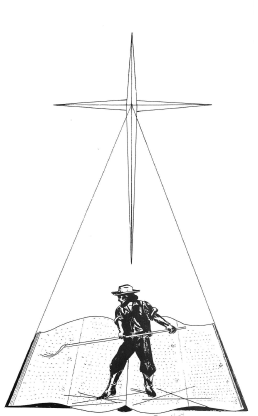
One thought on “Zerah Pulsipher’s Conversion”